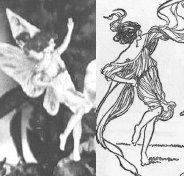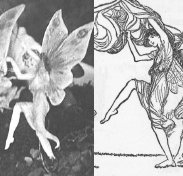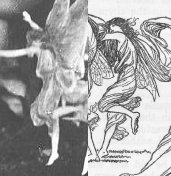In 1920 a series of photos of fairies captured the attention of the world. The photos had been taken by two young girls, the cousins Frances Griffith and Elsie Wright, while playing in the garden of Elsie's Cottingley village home. Photographic experts examined the pictures and declared them genuine. Spiritualists promoted them as proof of the existence of supernatural creatures, and despite criticism by skeptics, the pictures became among the most widely recognized photos in the world. It was only decades later, in the late 1970s, that the photos were definitively debunked.
The Origin of the Photographs
During World War I, ten-year-old Frances Griffiths, who was from South Africa, moved into the English home of her aunt and uncle, the Wrights, while her father fought in the war. She and her cousin, thirteen-year-old Elsie, often played together in the large garden of the family's Cottingley village home.
In July 1917 the pair asked to borrow the camera of Elsie's father, telling him they wanted to take a photo of the fairies they had been playing with all morning. Elsie's father laughingly agreed and showed them how to use the camera. An hour later the girls returned, declaring their project a success. And when Mr. Wright developed the plate that evening, he could see that there did indeed appear to be a fairy posing with Frances in the photo. However, he dismissed the girls' explanation, assuming the picture was some kind of trick. He asked Elsie why there appeared to be "bits of paper" in the photo.
Even when the girls took a second photo a little over a month later, showing Elsie with a gnome, the father treated the images as a joke and filed them away.
However, Elsie's mother, Polly Wright, had a stronger belief in the supernatural, and was more intrigued by the photos. In 1919 she attended a lecture on spiritualism and following it, she showed the photos to the speaker, asking him if they "might be true after all." The speaker brought the photos to the attention of Edward Gardner, a leader of the Theosophical movement, who in turn asked a photographer, Harold Snelling, to examine them. Snelling declared the photos were "genuine unfaked photographs of single exposure, open-air work, show movement in all the fairy figures, and there is no trace whatever of studio work involving card or paper models, dark backgrounds, painted figures, etc."
Once they had received this stamp of approval, the fairy images began circulating throughout the British spiritualist community, and soon came to the attention of Sir Arthur Conan Doyle, author of the Sherlock Holmes mysteries. Doyle was a passionate believer in spiritualism, and he latched onto the images, convinced they were conclusive photographic proof of the existence of supernatural fairy beings.
At Doyle's urging, the girls took three more pictures of fairies in August 1920. Doyle then wrote an article about the photographs that appeared in the December 1920 issue of
The Strand Magazine, in which he passionately argued for the authenticity of the images. This article brought the photos to the attention of the wider public and sparked an international controversy that pitted spiritualists against skeptics.
The Photos
Shown below are the five Cottingley fairy photos, in the order in which they were taken. The text of the accompanying descriptions comes from
Fairies: The Cottingley Photographs and Their Sequel by Edward Gardner (published 1945).
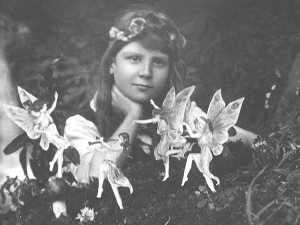 #1. Frances and the Fairies.
#1. Frances and the Fairies. Taken July 1917. Camera: Midg Quarter. "The negative was a little over-exposed. The waterfall and rocks are about 20 feet distance behind Frances, who is standing in shallow water inside the bank of the beck. The colouring of the fairies was described by the girls as shades of green, lavender and mauve, most marked in the wings and fading to almost pure white in the limbs and drapery."
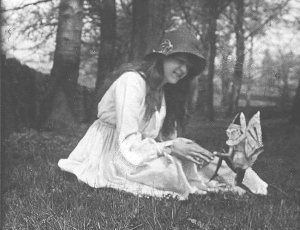 #2. Elsie and the Gnome.
#2. Elsie and the Gnome. Taken September 1917. Camera: Midg Quarter. "Elsie was playing with the gnome and beckoning it to come on to her knee. The gnome leapt up just as Frances, who had the camera, snapped the shutter. He is described as wearing black tights, a reddish jersey and a pointed bright red cap. Elsie said there was no perceptible weight, though when on the bare hand the feeling is like a 'little breath'. The wings were more moth-like than the fairies and of a soft neutral tint. Elsie explained that what seem to be markings on his wings are simply his pipes, which he was swinging in his grotesque little left hand."
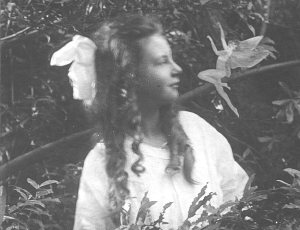 #3. Frances and the Leaping Fairy.
#3. Frances and the Leaping Fairy. Taken August 1920. Camera: Cameo Quarter. "The fairy is leaping up from the leaves below and hovering for a moment—it had done so three or four times. Rising a little higher than before, Frances thought it would touch her face, and involuntarily tossed her head back. The fairy's light covering appears to be close fitting: the wings were lavender in colour."
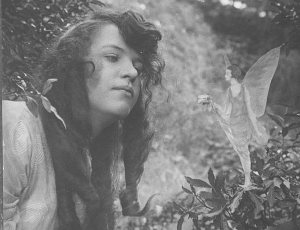 #4. Fairy Offering a Posy to Elsie.
#4. Fairy Offering a Posy to Elsie. Taken August 1920. Camera: Cameo Quarter. "The fairy is standing almost still, poised on the bush leaves. The wings were shot with yellow. An interesting point is shown in this photograph: Elsie is not looking directly at the sprite. The reason seems to be that the human eye is disconcerting. If the fairy be actively moving it does not matter much, but if motionless and aware of being gazed at then the nature-spirit will usually withdraw and apparently vanish. With fairy lovers the habit of looking at first a little sideways is common."
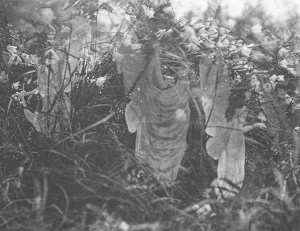 #5. Fairies and Their Sun-Bath.
#5. Fairies and Their Sun-Bath. Taken August 1920. Camera: Cameo Quarter. "This is especially remarkable as it contains a feature quite unknown to the girls. The sheath or cocoon appearing in the middle of the grasses had not been seen by them before, and they had no idea what it was. Fairy observers of Scotland and the New Forest, however, were familiar with it and described it as a magnetic bath, woven very quickly by the fairies and used after dull weather, in the autumn especially. The interior seems to be magnetised in some manner that stimulates and pleases."
Controversy
Skeptics noticed many problems with the photos, in addition to the obvious one that the fairies look like bits of paper. For instance, in the first photo why is Frances not looking at the fairies? (The girls claimed they were so used to the fairies that they often paid them no attention.) And why does the second fairy from the left not have wings? In the second photo, why is Elsie's hand bizarrely elongated? (Frances attributed this to "camera slant.") In the fourth photo, why is the fairy dressed in the latest French fashions?
Despite these problems, the photos continued to attract believers. Much of this belief might be attributed to the context of the times. By the end of World War One the English were emotionally bruised and battered by four years of unrelenting bloodshed. They seemed to be in need of something that would reaffirm their belief in goodness and innocence. They found this reaffirmation in the fairy photographs of Frances and Elsie.
Debunked
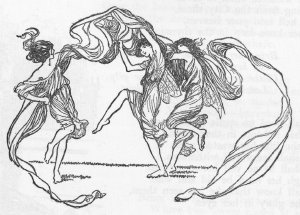
Fairy figures in
Princess Mary's Gift BookIt was not until 1978 that James Randi pointed out that the fairies in the pictures were very similar to figures in a children's book called
Princess Mary's Gift Book, which had been published in 1915 shortly before the girls took the photographs.
Subsequently, in 1981, Elsie Wright confessed to Joe Cooper, who interviewed her for
The Unexplained magazine, that the fairies were, in fact, paper cutouts. She explained that she had sketched the fairies using
Princess Mary's Gift Book as inspiration. She had then made paper cutouts from these sketches, which she held in place with hatpins. In the second photo (of Elsie and the gnome) the tip of a hatpin can actually be seen in the middle of the creature. Doyle had seen this dot, but interpreted it as the creature's belly button, leading him to argue that fairies give birth just like humans!
Below is a side-by-side comparison of the figures in
Princess Mary's Gift Book and the fairies in the first Cottingley fairy photo.
Copyright Controversy
The copyright status of the Cottingley fairy photos is contested. The
Science and Society Picture Library, claiming to represent the photographers' estate, has asserted exclusive right to license the use of the images. In May 2005 it sent
infringement notices to many sites (including the Museum of Hoaxes) that were displaying the photos. It demanded fees of up to 130.00 GBP per year for the right to display each image.
The Museum of Hoaxes believes the Cottingley images to be in the public domain, and therefore did not remove the photos, nor has it agreed to pay a licensing fee for their use. The basis of our belief is that the images were published before 1923 in America. Specifically, they appeared in Arthur Conan Doyle's
The Coming of the Fairies, published in 1922 by George H. Doran Co., New York. According to American law, all works published in this country before 1923 are in the public domain.
The status of the Cottingley images under British law is less clear cut, since British law grants continuing copyright to photographs taken before January 1, 1945 if the copyright has been revived. It is not clear whether or not the copyright to the Cottingley Fairy images was revived.
The possibly conflicting status of the Cottingley images under American and British law places them in an ambiguous legal situation. It is not clear which countries copyright law has priority. A possible precedent can be found in the case of J.M. Barrie's
Peter Pan, which is copyrighted in the UK, but is in the public domain in the US. Efforts to enforce the UK copyrights in America have been unsuccessful. When Project Gutenberg made the text of Peter Pan freely available on its site, it simply added a disclaimer noting that the text was public domain in the U.S., but not elsewhere.
Whether or not the Cottingley images are copyrighted, a strong case can be made that their use by sites such as the Museum of Hoaxes is protected by fair use laws — referred to as "fair dealing" laws in Great Britain — since they are displayed for the purpose of comment and criticism.
Cottingley Fairies Haiku (Submitted by Hoax Museum visitors)
Camera ready,
Two young girls patiently wait —
Fairy paparazzi!
(by AB)
|
Holmes' writer thought that
Cottingley faires were real.
He is no Sherlock
(by Sharruma)
|
Floating on branches
Your gossamer wings ably
Conceal the hat pins
(by bobbaxter)
|
Magic is tricky
But I wanted to believe
I should have known better
(by Victoria)
|
Flying wonders and
Comical gnomes are waiting
Just beyond the truth
(by Victoria)
|
Gullibility
Eye openers were common
Were faeries drunk, too?
(by Fuzzfoot)
|
Clever little girls
with their father's camera
brought magic to the world
(by Amy G)
|
|
Links and References

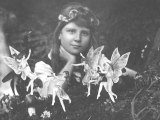
 #1. Frances and the Fairies. Taken July 1917. Camera: Midg Quarter. "The negative was a little over-exposed. The waterfall and rocks are about 20 feet distance behind Frances, who is standing in shallow water inside the bank of the beck. The colouring of the fairies was described by the girls as shades of green, lavender and mauve, most marked in the wings and fading to almost pure white in the limbs and drapery."
#1. Frances and the Fairies. Taken July 1917. Camera: Midg Quarter. "The negative was a little over-exposed. The waterfall and rocks are about 20 feet distance behind Frances, who is standing in shallow water inside the bank of the beck. The colouring of the fairies was described by the girls as shades of green, lavender and mauve, most marked in the wings and fading to almost pure white in the limbs and drapery." #2. Elsie and the Gnome. Taken September 1917. Camera: Midg Quarter. "Elsie was playing with the gnome and beckoning it to come on to her knee. The gnome leapt up just as Frances, who had the camera, snapped the shutter. He is described as wearing black tights, a reddish jersey and a pointed bright red cap. Elsie said there was no perceptible weight, though when on the bare hand the feeling is like a 'little breath'. The wings were more moth-like than the fairies and of a soft neutral tint. Elsie explained that what seem to be markings on his wings are simply his pipes, which he was swinging in his grotesque little left hand."
#2. Elsie and the Gnome. Taken September 1917. Camera: Midg Quarter. "Elsie was playing with the gnome and beckoning it to come on to her knee. The gnome leapt up just as Frances, who had the camera, snapped the shutter. He is described as wearing black tights, a reddish jersey and a pointed bright red cap. Elsie said there was no perceptible weight, though when on the bare hand the feeling is like a 'little breath'. The wings were more moth-like than the fairies and of a soft neutral tint. Elsie explained that what seem to be markings on his wings are simply his pipes, which he was swinging in his grotesque little left hand." #3. Frances and the Leaping Fairy. Taken August 1920. Camera: Cameo Quarter. "The fairy is leaping up from the leaves below and hovering for a moment—it had done so three or four times. Rising a little higher than before, Frances thought it would touch her face, and involuntarily tossed her head back. The fairy's light covering appears to be close fitting: the wings were lavender in colour."
#3. Frances and the Leaping Fairy. Taken August 1920. Camera: Cameo Quarter. "The fairy is leaping up from the leaves below and hovering for a moment—it had done so three or four times. Rising a little higher than before, Frances thought it would touch her face, and involuntarily tossed her head back. The fairy's light covering appears to be close fitting: the wings were lavender in colour."  #4. Fairy Offering a Posy to Elsie. Taken August 1920. Camera: Cameo Quarter. "The fairy is standing almost still, poised on the bush leaves. The wings were shot with yellow. An interesting point is shown in this photograph: Elsie is not looking directly at the sprite. The reason seems to be that the human eye is disconcerting. If the fairy be actively moving it does not matter much, but if motionless and aware of being gazed at then the nature-spirit will usually withdraw and apparently vanish. With fairy lovers the habit of looking at first a little sideways is common."
#4. Fairy Offering a Posy to Elsie. Taken August 1920. Camera: Cameo Quarter. "The fairy is standing almost still, poised on the bush leaves. The wings were shot with yellow. An interesting point is shown in this photograph: Elsie is not looking directly at the sprite. The reason seems to be that the human eye is disconcerting. If the fairy be actively moving it does not matter much, but if motionless and aware of being gazed at then the nature-spirit will usually withdraw and apparently vanish. With fairy lovers the habit of looking at first a little sideways is common." #5. Fairies and Their Sun-Bath. Taken August 1920. Camera: Cameo Quarter. "This is especially remarkable as it contains a feature quite unknown to the girls. The sheath or cocoon appearing in the middle of the grasses had not been seen by them before, and they had no idea what it was. Fairy observers of Scotland and the New Forest, however, were familiar with it and described it as a magnetic bath, woven very quickly by the fairies and used after dull weather, in the autumn especially. The interior seems to be magnetised in some manner that stimulates and pleases."
#5. Fairies and Their Sun-Bath. Taken August 1920. Camera: Cameo Quarter. "This is especially remarkable as it contains a feature quite unknown to the girls. The sheath or cocoon appearing in the middle of the grasses had not been seen by them before, and they had no idea what it was. Fairy observers of Scotland and the New Forest, however, were familiar with it and described it as a magnetic bath, woven very quickly by the fairies and used after dull weather, in the autumn especially. The interior seems to be magnetised in some manner that stimulates and pleases."
